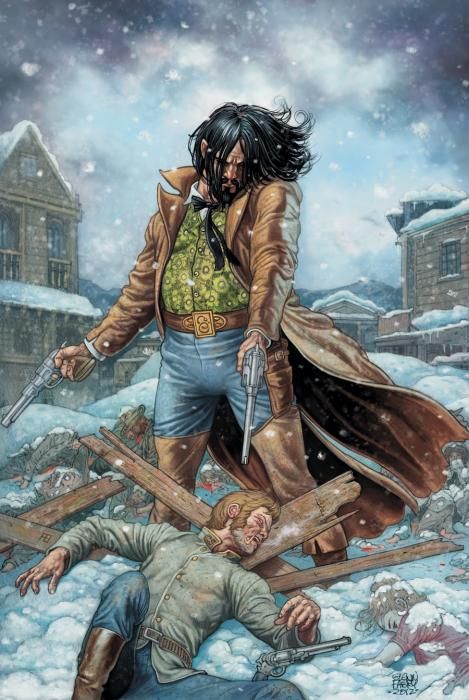The adventures of oddest-of-all couple Jonah Hex and Amadeus Arkham continue in "All-Star Western" #18, drawn by Moritat to fit the words by Jimmy Palmiotti and Justin Gray. While quite capable of being read as a done-in-one, this issue carries on the tale of the Death's Doorstep neighborhood of Gotham during the cholera outbreak. That location serves as a junction point for the paths of the Arkhams, the Waynes, Jonah Hex and Vandal Savage.
Sitting next to my dad, Kung Fu and Clint Eastwood movies were my introduction to westerns, but Jonah Hex as written by Palmiotti and Gray is how I think of westerns nowadays, despite the fact that much of "All-Star Western," to this point has been set in Gotham. Hex is a take-no-crap character that does the right things most of the time, even if it isn't for the right reasons. Palmiotti and Gray have written Hex adventures for over eight years, and they certainly don't appear to be anywhere near out of ideas. In that same regard, Hex continues to be every bit as entertaining when written by this duo in the present as he was in Palmiotti and Gray's first issue in 2005. Abrasive, solitary and brash, Hex's personality brings out the personalities of those around him and makes him a much cooler character for it. The preference for Hex to be by himself opens the writing duo up to narrate the adventures as much as they script the action and choreograph the fighting.
On that point, Rob Leigh's lettering deserves recognition. The caption boxes are set in a woodcut font, which makes the tale those rectangles carry more engaging and nearly narrational, as though you can almost hear Bill Woodson speaking the words over your shoulder. Leigh, like Palmiotti and Gray, contributes to both the feature and the backup, but his style changes in between, settling into a more common appearance. Despite this praise, I discovered a bobble in the Stormwatch and Doctor Terrence Thirteen backup on a word balloon that attributes dialogue said to Dr. Thirteen as said by him instead.
Moritat's artwork is clean and solid, deftly blending thick outlines with tight, slim detailed interior lines to all of his characters. Hex doesn't have the greatest range of expressions (obviously) but Moritat is able to communicate Hex's emotions through posture and movement. The other characters in the story are well designed and smooth, expressive and consistent. Moritat's style, like this book, is quite unlike anything else DC currently publishes. In addition to strong character work, Moritat delivers amazingly detailed backgrounds and gets a remarkable assist from his colorist. As much of the lead story occurs during winter, Mike Atiyeh steps up his game, giving depth, dimension and temperature to the surroundings.
The Dr. Thirteen tale is less exciting than Hex's tale, but it props up yet another connection across the DC Universe by bringing Thirteen, who is chummy with Amadeus Arkham, into contact with Stormwatch. While it's clear Gray and Palmiotti put as much care and attention into the backup as the main story, without Hex, the last ten pages of "All-Star Western" #18 are a bit of a letdown. Staz Johnson draws a solid story of Dr. Thirteen attempting to bust some myths in rural New York, but his characters are more wooden than Moritat's.
"All-Star Western" #18 is a fabulous sampler of what Palmiotti and Gray do so well -- brilliant characterization, electrifying action and dark humor. As this issue concludes, the writing duo sets up more adventures for Hex elsewhere and also promise "the most unexpected guest star." Not only do readers have that to look forward to, but as of this issue, Hex has also run afoul of Vandal Savage, teasing plenty of great Jonah Hex stories waiting to happen.

